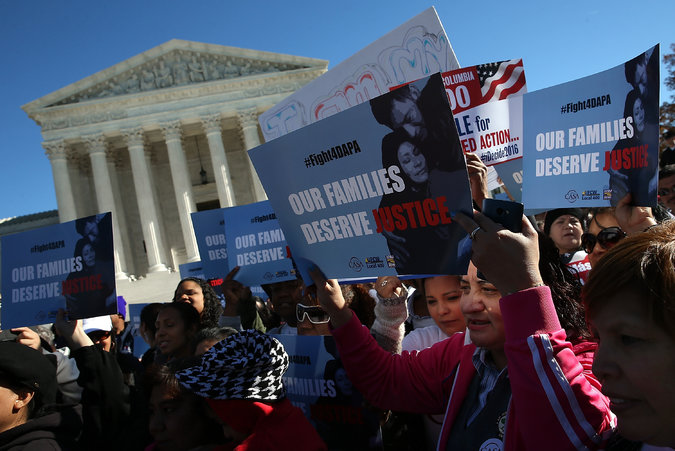
“Landmark Decision Set for this Summer on Immigration and the Executive Order”
By Zachary J. Zabawa, Staff Writer
This summer the eyes of the nation will be fixed upon the United States Supreme Court like never before. Not only is a battle brewing concerning whether or not to hold confirmation hearings for President Obama’s replacement for the late Justice Scalia, but the Court will also take up a decision critical to the legacy of the President. The Supreme Court is set to decide whether or not the President’s Executive Order relating to immigration is, in fact, within the bounds of the Constitution.[1]
As of January of this year, the Supreme Court has decided to listen to challenges regarding President Obama’s Executive Order on Immigration, called DAPA. DAPA, or the Deferred Action for Parents of Americans and Lawful Permanent Residents, is a planned immigration policy to allow undocumented immigrants who arrived in this country prior to Jan. 1st, 2010 to apply for deferred action and remain without threat of deportation. The deferred action is applicable to immigrants with children who are either American citizens or have permanent residence status. This status does not provide citizenship to the alien, rather it provides the opportunity to apply for a renewable work permit without the fear of deportation.[2] The predecessor to DAPA was passed in 2012 and was titled DACA, the Deferred Action for Childhood Arrivals. DACA already benefits some 800,000 aliens who were brought to the United States as children. DAPA is essentially an expansion of DACA program.[3] DAPA currently has no beneficiaries because the 5th Circuit has imposed an injunction pending the decision of the Supreme Court.[4]
The Supreme Court is likely to examine whether the President has the power to issue such far-reaching Executive Orders that alter Congressionally passed legislation.[5] There is a possibility that the Court ignores the original issue concerning the Immigration and Nationality Act and instead considers the broad issue concerning the Presidential Obligation “to take care that the laws be faithfully executed,” known as the Take Care Clause under Article II Sec 3 of the Constitution.[6] In the past, the President has resorted to similar Executive Actions in the face of the unprecedented Congressional inaction and reluctance to collaborate on issues. This challenge has arisen to confront the President’s tendency to act unilaterally in the face of resistance. Republicans in Congress and Governors of states facing the brunt of this immigration policy have been critical of the measure that circumvents the legislative process.[7]
The challenge before the Supreme Court consists of 26 states and the litigation is being led by the State of Texas.[8] The current case is proceeding to the Supreme Court under the heading Texas v. United States. Texas Attorney General Ken Paxton initially brought the case before the District Court for the Southern District of Texas.[9] The crux of the challenge to DAPA is that it violated the Administrative Procedure Act, which regulates how and to what extent Federal Executive Agencies can impose sweeping regulations.[10]
Arguments were set to be heard this spring and decided by summer, but now all remains uncertain in light of the loss of Justice Antonin Scalia from the bench.[11] What is clear is that this ruling will be fundamental to future presidencies and the nature of the American Democracy.[12] Not only is the status of some 5 million undocumented immigrants at stake, but also the extent of executive authority and the limits of the Executive Order.[13] Fasten your seat belts, this is the summer of the Supreme Court and the showdown has only just begun.
[1] Nelson, Steve. “Dreamer’s Nightmare: DACA Dies If Obama Immigration Action Goes Down.” US News and World Report. January 19, 2016. Accessed February 28, 2016. http://www.usnews.com/news/articles/2016-01-19/dreamers-nightmare-daca-dies-if-obama-immigration-actions-go-down.
[2] “Deferred Action for Childhood Arrivals (DACA) and Deferred Action for Parents of Americans and Lawful Permanent Residents (DAPA).” Deferred Action for Childhood Arrivals (DACA) and Deferred Action for Parents of Americans and Lawful Permanent Residents (DAPA). Accessed February 28, 2016. https://www.ice.gov/daca.
[3] Nelson.
[4] Epps, Garrett. “Will the Supreme Court Tell Obama to “Take Care”” The Atlantic. January 21, 2016. Accessed February 28, 2016. http://www.theatlantic.com/politics/archive/2016/01/supreme-court-united-states-texas/425031/.
[5] Liptak, Adam, and Michael Shear. “Supreme Court to Hear Challenge to Obama Immigration Actions.” The New York Times. January 19, 2016. Accessed February 28, 2016. http://www.nytimes.com/2016/01/20/us/politics/supreme-court-to-hear-challenge-to-obama-immigration-actions.html?_r=0.
[6] Epps.
[7] Fitz, Marshall. “Is Obama’s Immigration Executive Order Legal?” US News. November 21, 2014. Accessed February 28, 2016. http://www.usnews.com/debate-club/is-obamas-immigration-executive-order-legal.
[8] Epps.
[9] Liptak.
[10] De Vogue, Ariane. “Obama Administration Wants Supreme Court to Lift Immigration Block.” CNN. November 10, 2015. Accessed February 28, 2016. http://www.cnn.com/2015/11/09/politics/obama-immigration-appeals-court-ruling/.
[11] Liptak.
[12] Epps.
[13] Nelson.